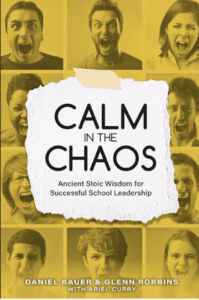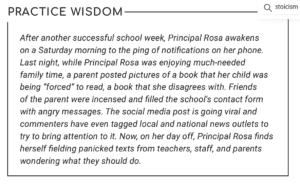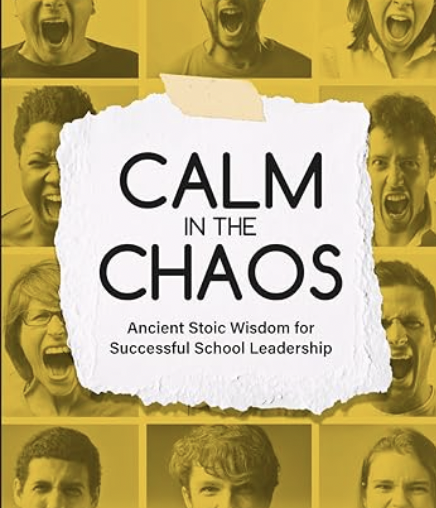 I have been deep-diving into Stoicism these past two years through the books and podcast of Ryan Halliday (aka: The Daily Stoic). When I was introduced to Danny Bauer, one of the authors of “Calm in the Chaos”, it was clear that he was a learning-practitioner of Stoicism in the educational context and culture. Chief Ruckus Maker at Better Leaders, Better Schools, Danny has been a classroom educator, and Vice Principal in schools in the U.S., and has turned his energy to creating better leaders through sustainable leadership practices.
I have been deep-diving into Stoicism these past two years through the books and podcast of Ryan Halliday (aka: The Daily Stoic). When I was introduced to Danny Bauer, one of the authors of “Calm in the Chaos”, it was clear that he was a learning-practitioner of Stoicism in the educational context and culture. Chief Ruckus Maker at Better Leaders, Better Schools, Danny has been a classroom educator, and Vice Principal in schools in the U.S., and has turned his energy to creating better leaders through sustainable leadership practices.
You would be interested in this book if you…
(1) Were looking for touchstones and strategies to make your energy more sustainable
(2) Were interested in leadership practices and case studies
(3) Wanted an opportunity to reflect on leadership practices within a school context
(4) Are suffering in your leadership role, and looking for strategies to balance and respond effectively
Stoicism in a School:
“We don’t claim to be experts on Stoicism. Neither of us has a philosophy degree. Rather, having seen the power of Stoicism in our lives and in our leadership at schools—not just for us, but for the people we serve— we want to share it with you.” (pg. 5)
I’ve really enjoyed learning about the practices of Stoicism within the context of a school. The authors all have different experiences of leading in schools, and boards / districts. It is this context and their examples, that bring the ancients to life for me.
“But whatever is right springs from one of four sources. It consists either in the perception and skilful treatment of the truth; or in maintaining good-fellowship with men, giving to every one his due, and keeping faith in contracts and promises; or in the greatness and strength of a lofty and unconquered mind; or in the order and measure that constitute moderation and temperance.” • Cicero (1887, Book I.5)
In this quotation lie the 4 virtues of Stoicism and the result: equanimity. The book is divided into 5 chapters that introduce and explain, show in practice, and then provoke the reader to understand and reflect upon, the four virtues of Stoicism: Wisdom, Justice, Temperance and Courage.
Strategies and Touchstones:
Beyond the quotations from the ancients, which act as indelible touchstones for leaders in any industry, there are some great strategies that lie within. A great example of a touchstone phrase is on page 16:
According to author and speaker Danny Silk (2015), “being right doesn’t have to be sacrificed, but having to be the one who is right needs to go” (Foreword, para. 4).
Each of the four virtues are complex and nuanced in practice. The authors do a wonderful job of bringing the practice and understanding to educators:
We’ve already talked about the things we do and do not have complete control over. But what about that third category? Although not everything is in your control, many things are within your influence. In school, your leadership exists in this middle ground, a gray area where you can influence outcomes but not control them. What are examples of things you have some control over but not complete control?
These reflective prompts are throughout the book, and ask us – the reader – to consider our response. That is why it is my recommendation that you take your time through this book, and take them up on their offer to pause, breath, consider and respond.

These opportunities are more overt in the case-studies throughout the book, and I highly recommend taking the time with each.
This Book is Balance:
I really love having this book near me, eventhough I’ve only had it for less than two weeks. I can pop it open anywhere and there are great exercises, touchstone and strategies that are immediately applicable to my learning-leadership journey. So, I thought that I would practice this here on this blog. I opened up the book to a random spot and this is what came up:
“History is filled with great leadership heroes who have managed situations exactly like the one you’re going through. This is why the Stoics saw reading as one of the best ways to develop wisdom—because through books, you can learn from the greatest minds that have ever lived. And what about the antiheroes, the people you want to be nothing like? You can be thankful for them, too. Yes, avoid behaving like them and surround yourself with better mentors—but do watch the antiheroes. Watch how they act and how their actions impact the people around them. Watch how they continue to keep education stuck. Learn from their mistakes. Then ask yourself: What kind of leader do I want to be?”
- If you follow my blog, you know that I am avid reader ~ how am I demonstrating and putting into practice what I have learned? How am I sharing it?
- What about, what the Stoics call, “Adversarial Learning”: where you have anti-heroes, or those that you work with who can teach you more about yourself through your response to their negativity? Or, can teach you more about who you do not want to be as a leader?
- Look for mentors… always, and everywhere
- Be reflective
I would highly recommend this book for any leader in education, regardless of their knowledge of Stoicism. It is a valuable read, and a great series of exercises to continue your learning-leadership journey. I would also recommend that you check out Danny’s Podcast: Better Leaders, Better Schools.
